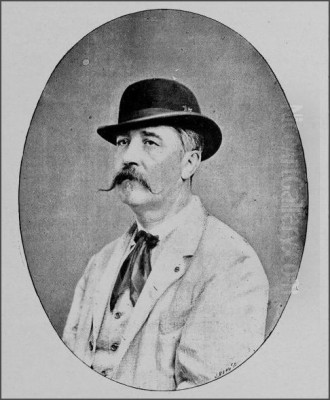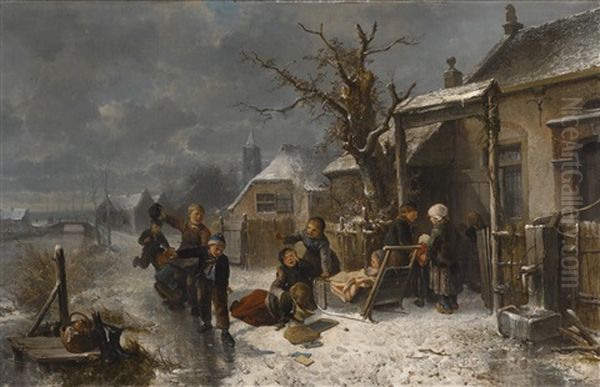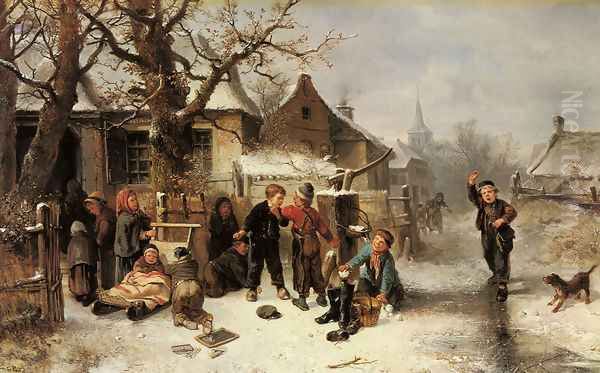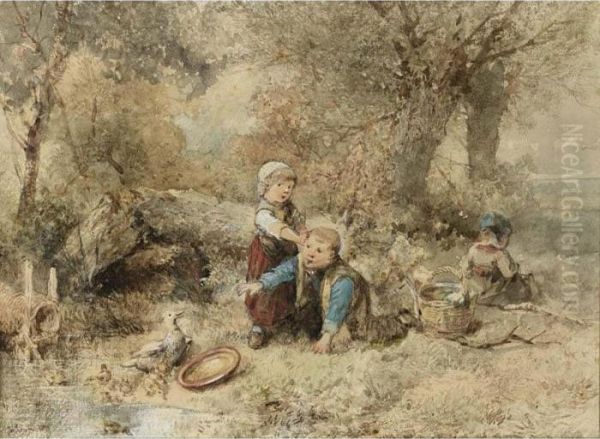
Johan Mari Henri Ten Kate, known widely as Mari ten Kate, stands as a significant figure in nineteenth-century Dutch art. Born in The Hague on March 4, 1831, and passing away in Driebergen on March 26, 1910, his life spanned a period of rich artistic development in the Netherlands. Ten Kate carved a distinct niche for himself, becoming particularly celebrated for his charming and meticulously rendered depictions of children, set against the backdrops of Dutch rural and coastal landscapes. His work, imbued with a romantic sensibility and a keen eye for detail, found favour not only in his homeland but also internationally, particularly in Great Britain.
Early Life and Artistic Formation
Mari ten Kate's journey into the world of art began in the administrative capital of the Netherlands, The Hague. His artistic inclinations were likely nurtured within his family environment, most notably through the influence of his elder brother, Herman Frederik Carel ten Kate (1822-1891). Herman was already establishing himself as a painter, known for his historical genre scenes, often depicting tavern interiors, guardrooms, and military life, frequently referencing the Dutch Golden Age. This familial connection provided Mari with an early exposure to the life of a professional artist.
Formal training commenced at the prestigious Royal Academy of Art in The Hague. This institution provided him with a solid foundation in drawing and painting techniques, essential for the detailed style he would later develop. He further honed his skills, likely attending the State Academy of Fine Arts (Rijksakademie van beeldende kunsten) in Amsterdam, a major centre for artistic education in the Netherlands during that period. These formative years equipped him with the technical proficiency needed to translate his observations into finely crafted artworks.
The influence of his brother Herman was significant, yet Mari quickly diverged in his choice of subject matter. While Herman looked to historical settings and robust, often masculine, themes, Mari gravitated towards contemporary life, finding particular inspiration in the world of children. This focus would become the hallmark of his career, distinguishing his work within the broader landscape of Dutch art.
A Romantic Vision: Style and Themes

Mari ten Kate's artistic style is best characterized as belonging to the later phase of Dutch Romanticism, blended with a strong element of genre painting. His approach was marked by a meticulous attention to detail, a smooth finish, and a warm, often sentimental, atmosphere. Unlike the looser, more atmospheric brushwork that would come to define the Hague School later in the century, Ten Kate maintained a high degree of finish and narrative clarity in his compositions.
His primary theme was childhood. He excelled at capturing the perceived innocence, spontaneity, and joy of children engaged in various activities. Whether playing by a canal side, exploring a beach, interacting with animals, or participating in simple domestic chores, his young subjects are depicted with empathy and charm. These scenes often convey an idealized vision of rural and coastal life, emphasizing harmony between humanity and nature.
Beyond children, Ten Kate's oeuvre included landscapes, beach scenes, depictions of peasant life, and occasional hunting scenes. However, it was his focus on the world of children that resonated most strongly with collectors and the public. He often set these scenes in picturesque environments – sunny dunes, snowy village streets, cozy cottage interiors, or tranquil canal banks – enhancing the idyllic and heartwarming quality of his work. The changing seasons frequently feature, allowing him to explore different light effects and activities, from ice skating in winter to seaside play in summer.
The World of Children
The enduring appeal of Mari ten Kate's work lies significantly in his sensitive portrayal of children. In an era that increasingly sentimentalized childhood, Ten Kate's paintings tapped into a widespread appreciation for images of youthful innocence and simple pleasures. His children are typically rosy-cheeked, well-dressed (often in traditional Dutch attire), and engaged in wholesome activities. They are shown interacting naturally with each other, with adults, or with animals, creating narratives that are both engaging and emotionally resonant.
He depicted children across various social settings, though often favouring rural or fisherfolk communities. Scenes might include children helping with chores, like gathering firewood or feeding chickens, learning lessons, or simply lost in play. He captured moments of quiet concentration, boisterous fun, and gentle interaction. The settings, whether interiors or exteriors, are rendered with care, providing a rich context for the figures and contributing to the overall narrative charm.

His ability to render textures – the rough wool of a coat, the smoothness of ice, the softness of sand, the feathers of a bird – added to the realism and appeal of his work. While idealized, his depictions were grounded in careful observation of children's postures, expressions, and interactions, lending them a believable quality despite the romantic overlay.
Representative Works
Several paintings exemplify Mari ten Kate's characteristic style and subject matter. Children Playing by a Canal in Winter is a classic example, showcasing his skill in depicting a snowy landscape populated by lively children engaged in winter activities like skating or pulling sleds. The crisp atmosphere, detailed rendering of figures and setting, and overall sense of cheerful community are typical of his work.
Children at Play on the Beach captures a different mood, evoking the warmth and freedom of summer. Here, children might be seen building sandcastles, collecting shells, or paddling in the shallows, often under a bright, expansive sky. Ten Kate masterfully rendered the effects of light on sand and water, creating inviting scenes of seaside leisure. These beach scenes connect him to a broader tradition in Dutch art, but his focus remains firmly on the children's experiences.
Mother and Child Feeding the Birds highlights his interest in domestic intimacy and the relationship between humans and nature. Such works often feature cozy interiors or sheltered garden settings, emphasizing themes of nurturing, care, and the simple beauties of everyday life. The detailed rendering of the figures' clothing, the interior space, and the birds themselves demonstrates his technical finesse.
Other notable works, often appearing in auctions and collections, might include titles like The Little Fishers, Winter Fun, Gathering Wood, or A Helping Hand, all reinforcing his central themes. His painting The Sparrows, depicting children feeding birds, and Family in a Country Courtyard further illustrate his focus on gentle, everyday moments rendered with romantic charm.
Career Trajectory and Travels
Mari ten Kate's professional life saw him based in several key locations. He worked in Amsterdam for a significant period, from roughly 1850 to 1871, during which time he established his reputation. He then moved back to The Hague, residing there from 1871 to 1905. This period coincided with the flourishing of the Hague School, placing him geographically close to its members, although his style remained distinct.

His career also included a notable period spent working in London, from approximately 1880 to 1890. This decade abroad reflects the significant popularity his work enjoyed in Great Britain. Victorian audiences, with their taste for narrative painting and sentimental themes, found Ten Kate's depictions of childhood particularly appealing. His presence in London likely facilitated direct access to this lucrative market.
Beyond these main bases, Ten Kate was an avid traveller. He journeyed to Paris, the epicentre of the European art world, and to Italy, a traditional destination for artists seeking inspiration from classical antiquity and Renaissance masters. More unusually for the time, he also travelled to the Dutch East Indies (modern-day Indonesia), specifically Java. While Indonesian subjects do not appear to dominate his known work, such travels would undoubtedly have broadened his horizons and potentially introduced new elements or perspectives into his art, even if subtly. His final years, from 1905 until his death in 1910, were spent in Driebergen, a town in the province of Utrecht.
Context within Dutch Art: Romanticism and The Hague School
To fully appreciate Mari ten Kate's contribution, it's essential to place him within the context of 19th-century Dutch art. He emerged during the later stages of Dutch Romanticism, a movement characterized by idealized landscapes, historical scenes, and often a nostalgic or sentimental mood. Painters like Barend Cornelis Koekkoek (1803-1862), renowned for his meticulously detailed summer and winter landscapes, and Andreas Schelfhout (1787-1870), a master of winter scenes and seascapes, were leading figures of the preceding generation whose work shared a similar emphasis on fine detail and idealized nature.
However, Ten Kate's career overlapped significantly with the rise of the Hague School, a movement that represented a shift towards Realism. Artists associated with the Hague School, such as Jozef Israëls (1824-1911), Anton Mauve (1838-1888), Hendrik Willem Mesdag (1831-1915), Jacob Maris (1837-1899), Willem Maris (1844-1910), and Matthijs Maris (1839-1917), favoured more muted palettes (often described as 'grey'), looser brushwork, and a focus on capturing the atmospheric qualities of the Dutch landscape and the unvarnished realities of peasant and fisherfolk life. Other key figures included the church interior painter Johannes Bosboom (1817-1891), and landscape painters Willem Roelofs (1822-1897) and Paul Gabriël (1828-1903).

While a contemporary and geographically close to the Hague School artists (especially during his 1871-1905 period in The Hague), Mari ten Kate's style remained distinct. He did not adopt their tonal 'grey school' palette or their looser technique. His work retained the brighter colours, detailed finish, and more overtly sentimental or anecdotal quality associated with earlier Romantic and genre traditions. He shared subject matter like coastal scenes (with Mesdag) or rural life (with Israëls or Mauve), but his interpretation was generally more polished, picturesque, and less focused on the hardships of labour. His approach can also be compared to other Dutch genre painters of the time, like David Bles (1821-1899), who also focused on narrative scenes rendered with precision.
Reception, Popularity, and Legacy
Mari ten Kate achieved considerable success and popularity during his lifetime. His charming subjects, accessible style, and technical skill appealed to a broad audience, particularly the burgeoning middle class who sought pleasant, narrative artworks for their homes. His paintings were regularly exhibited in the Netherlands and abroad, gaining him recognition and patronage.
His popularity extended significantly to the British market, as evidenced by his decade working in London. The themes of childhood innocence, domestic virtue, and picturesque rural life resonated strongly with Victorian sensibilities. This success was further amplified by the reproduction of his works as prints, particularly engravings and lithographs. These reproductions made his images widely accessible, cementing his fame and ensuring his motifs became familiar in many households, both in the Netherlands and internationally.
While perhaps not accorded the same level of critical acclaim by later art historians as the groundbreaking artists of the Hague School, Mari ten Kate holds a secure place in Dutch art history. He represents a continuation of the Romantic genre tradition, adapting it to contemporary tastes with considerable skill and charm. His specialization in the theme of childhood distinguishes him, and his works remain popular on the art market today, appreciated for their nostalgic appeal, decorative qualities, and masterful execution.
Later Life and Conclusion
Mari ten Kate spent the last five years of his life in Driebergen, continuing to work until his death in 1910. He left behind a substantial body of work that consistently explored his chosen themes with dedication and skill. His art offers a window into a particular aspect of 19th-century Dutch society and its values, particularly its idealization of childhood and rural life.

In summary, Johan Mari Henri Ten Kate was a highly proficient and successful Dutch painter of the Romantic tradition. Deeply influenced by his artistic family background and formal academic training, he developed a distinctive style characterized by fine detail, warm sentiment, and a focus on genre scenes, especially those involving children. He navigated the changing artistic landscape of the 19th century, maintaining his own popular style even as the Hague School moved towards Realism. Through his paintings and their widespread reproduction, Mari ten Kate created enduring images of Dutch life, filled with charm, innocence, and meticulous beauty, securing his legacy as a beloved master of genre painting. His work continues to delight viewers with its nostalgic portrayal of a simpler, more harmonious world.